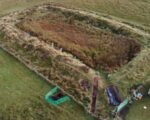A silent threat lurks in the waters of the Colorado River, a menace unseen yet deadly, posing a grave danger to our beloved canine companions. This peril is not a predator of flesh and blood, but a microscopic parasite known as Heterobilharzia americana, a liver fluke that has claimed the lives of dogs across Southern California.
The Invisible Enemy
The Colorado River, a lifeline for many, has become a potential death trap for dogs due to the presence of a lethal parasite. Heterobilharzia americana, previously confined to the Gulf states, has now been identified in the river’s Californian stretch, raising alarms among pet owners and veterinarians alike.
The parasite’s journey begins in snails, the unsuspecting hosts that line the riverbanks. From there, it seeks out mammals, with dogs being particularly vulnerable. The infection process is stealthy, with the parasite penetrating the skin and migrating to vital organs, causing severe damage and, in some cases, death.

The discovery was made by researchers from the University of California, Riverside, who, after investigating several cases of infected dogs, found the parasite’s DNA in snails collected from the river. This finding marks a significant and worrying shift in the parasite’s geographical spread.
A Community on Alert
The revelation of this parasitic invasion has sent shockwaves through communities along the Colorado River. Dog owners are now faced with the difficult decision of keeping their pets away from the water they love, a precaution necessary to avoid the fatal consequences of infection.
Veterinary clinics are reporting an uptick in cases of canine schistosomiasis, the disease caused by the liver fluke. Symptoms are often subtle at first, including loss of appetite and lethargy, but can escalate to severe liver disease and organ failure. The situation has prompted a public health advisory, urging vigilance and caution for those living near or visiting the river.
In response to the crisis, local authorities and animal welfare organizations are working together to increase awareness and educate the public on prevention strategies. The goal is clear: to protect our canine friends from this hidden danger and to prevent the parasite from claiming more lives.
Research and Resistance
As the community grapples with this new threat, scientists are delving deeper into the biology and behavior of Heterobilharzia americana. Understanding the parasite’s lifecycle and transmission is crucial for developing effective control measures and treatment options.
Efforts are underway to map the spread of the parasite and to identify potential hotspots along the river. Researchers are also exploring the possibility of environmental interventions that could disrupt the lifecycle of the liver fluke and reduce the risk of transmission.
The fight against Heterobilharzia americana is a battle on two fronts: one of public awareness and prevention, and the other of scientific research and innovation. It is a testament to the resilience and determination of a community united against a common foe.













